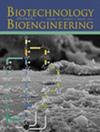Helicobacter pylori cells undergo chemotaxis toward several small molecules, called chemo-attractants, including urea produced by the epithelial cells of the stomach. The biophysical mechanisms of chemotaxis are not well understood in H. pylori. Here, we developed point sources of urea by encapsulating it in Poly(lactic-co-glycolic acid) or PLGA microbeads for H. pylori chemotaxis studies. Microscopy and Dynamic Light Scattering characterization indicated that the PLGA particles had an average diameter of < 0.8 μm. The particles were relatively stable and had a net negative surface charge. Absorbance measurements indicated that the beads released ~70% of the urea over a 2-week period, with most of the release occurring within the first 24-h period. Varying pH (2.0–7.0) had little effect on the rate of urea release. A diffusion model predicted that such beads could generate sufficient urea gradients to chemotactically attract H. pylori cells. Single-bead single-cell chemotaxis assays confirmed the predictions, revealing that H. pylori continued to be attracted to beads even after most of the urea had been released in the first 24 h. Our work highlights a novel use of PLGA microbeads as delivery vehicles for stimulating a chemotaxis response in H. pylori, with potential applications in bacterial eradication strategies.



